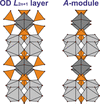issue contents
February 2022 issue

Cover illustration: Crystal growth morphologies of NIME in the bulk exhibit strong temperature dependence: (top right) 140°C, (top left) 80°C, (bottom left) 30°C and (bottom right) 18°C [see Shi et al. (2022). Acta Cryst. B78, 33–39].
research papers
Download citation


Download citation


An accurate single-crystal X-ray diffraction study of (Nd0.91Bi0.09)Fe3(BO3)4 was performed in the temperature range 20–500 K. The temperature-dependent behaviour of the structural parameters is compared with the behaviours of other rare-earth iron borates.
A method for searching for homometric structures using symmetry operations has been developed. The method was applied to the Inorganic Crystal Structure Database and homometric structures are found for 37 reported structures.
Download citation


Download citation


The crystal structure of the low-temperature 2O polytype of CuII3TeVIO6 (the mineral mcalpineite) has been determined by 3D electron diffraction (3D ED) and Rietveld refinement following X-ray powder diffraction (PXRD).
CCDC reference: 2110654
CHEMISTRY | CRYSTENG
Fiber growth of nimesulide, a precursor of glass-to-crystal growth in supercooled liquid, is reported.
Open  access
access
 access
accessThe structures of centrosymmetric perovskites (ABX3) are modelled by transforming crystallographic data into a Cartesian space defining BX6 octahedral tilting and distortion. Structural evolution and phase transitions under variable (p–T–X)-conditions are analysed and predicted.
The replacement of Na+ by alkali metal cations with larger ionic radii (Rb+ and Cs+) in compounds with the chemical formula A2Mg3(SO4)4 significantly changes the topology of the heteropolyhedral MT framework.
Download citation


Download citation


Two polymorphic forms of 1-allyl-4-hydroxy-2,2-dioxo-N-(4-methoxyphenyl)-1-2λ6,1-benzothiazine-3-carboxamide (a structural analogue of piroxicam) have different crystal structures from the energetic viewpoint and different biological activity. A slow polymorphic transition after grinding results in the loss of the biological activity.
MATERIALS | COMPUTATION
Topological analysis of the heteropolyhedral MT framework (where M and T are octahedral and tetrahedral cations, respectively) in the eudialyte-type structure and its derivatives was performed based on a natural tiling analysis of the 3D cation nets with the ToposPro software using both the standard representation and the 0-1-2-free representation.
Variable-temperature single-crystal synchrotron diffraction experiments treated with the Gandolfi method reveal the structural phase transitions and thermal expansivities for the energetic material FOX-7.

 journal menu
journal menu


































